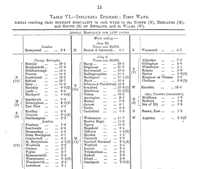why did it start here?
16/10/14 22:18
I was browsing around on histpop tonight looking for anything of interest and clicked on the supplement to the Registrar-General’s 81st report. As you do. This was a supplement reporting on the mortality from influenza in England and Wales in 1918-19, the ‘Spanish flu’ epidemic.
What I hadn’t realised before this was that amongst the earliest reports of flu related mortality were those from Bacup and Rawtenstall. The R-G does say that they cannot be certain that flu started its UK epidemic in these places as there were sporadic outbreaks roughly simultaneously indifferent parts of the country. What is clear however is that of the week ending June 29 1918 the highest mortality was returned from Bacup (33/1000) and the third highest from Rawtenstall (half as bad as Bacup at 18/1000) with Bacup in particular being miles ahead of anywhere else.

Bacup is 5 miles east of Springhill and Rawtenstall just less than a mile to the west, to this area was going to be affected, if only by fear. Interestingly whilst Bacup and Rawtenstall were severely affected, Whitworth and Haslingden, adjacent towns, escaped relatively lightly.
Spanish flu came in three waves; Bacup and Rawtenstall were relatively little affected by these subsequent waves. Presumably everyone had either died or become immune with sufficient herd immunity to prevent the virus from re-establishing itself.
Spanish flu is caused by H1N1 flu virus, more recently of swine flu fame. Like swine flu it was more severe in young adults rather than most flu which tends to affect the elderly more severely. There have been a variety of theories as to why this was the case in 1918, with many suggesting that mixing of peoples during WW1 lead to easier spread whilst the stresses of war reduced soldiers’ immunity. It is estimated that 5x more people died in the endemic than died in WW1.
But why here? Sure there were a large number of soldiers, but not more than many places. They did not predominantly join a single regiment or ‘Pals’ brigade. There is no port (40 miles from the sea!) or airport and minimal tourism or business travel. There was poverty and overcrowding, but again no worse than many industrial areas. And why were adjacent areas relatively unaffected?
Am going to have to do some thinking and reading here, and to revise my long-forgotten immunology.
Obituaries of some of the Bacup soldiers to die can be found in these extracts from the Bacup Times.
What I hadn’t realised before this was that amongst the earliest reports of flu related mortality were those from Bacup and Rawtenstall. The R-G does say that they cannot be certain that flu started its UK epidemic in these places as there were sporadic outbreaks roughly simultaneously indifferent parts of the country. What is clear however is that of the week ending June 29 1918 the highest mortality was returned from Bacup (33/1000) and the third highest from Rawtenstall (half as bad as Bacup at 18/1000) with Bacup in particular being miles ahead of anywhere else.

Bacup is 5 miles east of Springhill and Rawtenstall just less than a mile to the west, to this area was going to be affected, if only by fear. Interestingly whilst Bacup and Rawtenstall were severely affected, Whitworth and Haslingden, adjacent towns, escaped relatively lightly.
Spanish flu came in three waves; Bacup and Rawtenstall were relatively little affected by these subsequent waves. Presumably everyone had either died or become immune with sufficient herd immunity to prevent the virus from re-establishing itself.
Spanish flu is caused by H1N1 flu virus, more recently of swine flu fame. Like swine flu it was more severe in young adults rather than most flu which tends to affect the elderly more severely. There have been a variety of theories as to why this was the case in 1918, with many suggesting that mixing of peoples during WW1 lead to easier spread whilst the stresses of war reduced soldiers’ immunity. It is estimated that 5x more people died in the endemic than died in WW1.
But why here? Sure there were a large number of soldiers, but not more than many places. They did not predominantly join a single regiment or ‘Pals’ brigade. There is no port (40 miles from the sea!) or airport and minimal tourism or business travel. There was poverty and overcrowding, but again no worse than many industrial areas. And why were adjacent areas relatively unaffected?
Am going to have to do some thinking and reading here, and to revise my long-forgotten immunology.
Obituaries of some of the Bacup soldiers to die can be found in these extracts from the Bacup Times.




